Lancia Loraymo And The Loewy Logic of Industrial Design
By Brandes Elitch
ISBN-978-0-9909214-1-7
Fetherston Publishing, 2016
Hardbound, 11.5 by 9 inches, 128 pages
$59.95 USD plus shipping Order from www.loewylancia.com
Review by Pete Vack
Well, it finally arrived. I had asked the author, Brandes Elitch, if he would send me a finished copy of his book, not a spiral bound proof copy; the hands on, touchy-feely experience of the final hardbound product is important.
And indeed it was. Elitch’s long-awaited book on Raymond Loewy and the Loraymo came in a very elegant but simple white cardboard box. When that was opened, the cover stared at me and said, ‘Finally, here I am’; Lancia Loraymo And The Loewy Logic of Industrial Design with an artistically grainy color shot of the fabled and often misunderstood Loraymo beneath the title. Nice; impressive.
It had been a long road.
About 20 years ago Steve Snyder, Lancia nut and former shop owner, told his friend Elitch about rescuing the long lost Loraymo in California. Many years later, somewhere in 2014, Elitch thought the subject would be good for a short book, and knew that Steve still had the photos of the as found Loraymo and much more. There had already been several stories in the automotive press in the mid-1990s about the restoration of the Loraymo, but the full story had never been told.
Elitch, (who has been writing for VeloceToday since 2007) and I thought it would make a good subject for a VeloceToday Select book, as it was short and focused with a relatively small audience. And an Italian car designed by a French–American stylist was right up our alley. But the story grew as Steve came forth with new photos and Elitch made contact with Raymond Loewy’s son in law, David Hagerman, who got onboard and would eventually contribute a great deal more about both his father-in-law and the Loraymo (and write a superb Introduction). With sections on design, Loewy, Lancia and the Loraymo, Elitch’s book was getting too big for our signature series.
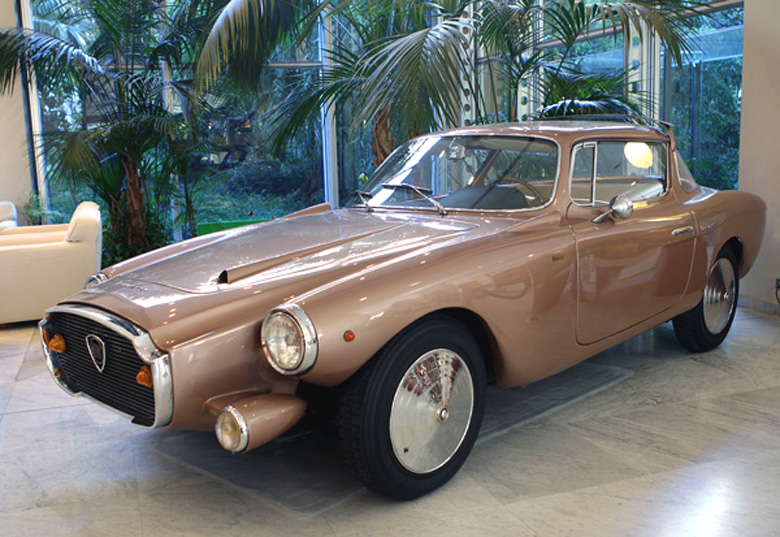
The Loraymo as photographed by Jonathan Sharp; a very unusual creation, designed for PR purposes rather than Pebble Beach.
At the same time, along came another publisher who essentially offered to do the layout in a very artistic manner worthy of Raymond Loewy himself, and use the new print-on-demand color service offered by Amazon. The publisher offered to do it for free as they needed the experience and publicity. This, we thought, would work out very well. Many meetings, schedules, conferences and contracts later, by mid-2015 we thought we were on the verge of creating a great new book about Loewy and the Loraymo.
Then, nothing. The publisher, who will remain nameless, simply stopped communicating with us, contract or not. None of us had any idea of why this occurred. Then Elitch remembered another friend of his, David Fetherston, who was also a publishing but concentrated on hot rod books. Since we had not heard from our errant publisher, we thought it time to move on and get Fetherston to finish the effort, which he did and in fine style.
The hardbound, 11 ¼ by 9 inch, 128 page book is well laid out on heavy gloss paper, and thank goodness for the large and clear font…easy on old eyes even though it adds to the page (and cost) count. Fetherston and company also did great work improving the quality of many of the photos taken of the car when owned by Dave Rives. They were copies of photos of photos (found and taken by Steve Snyder) and yet reproduced nicely. We should note here that many other images of the Loraymo today were taken by our own Hugues Vanhoolandt and Jonathan Sharp and add greatly to the book.
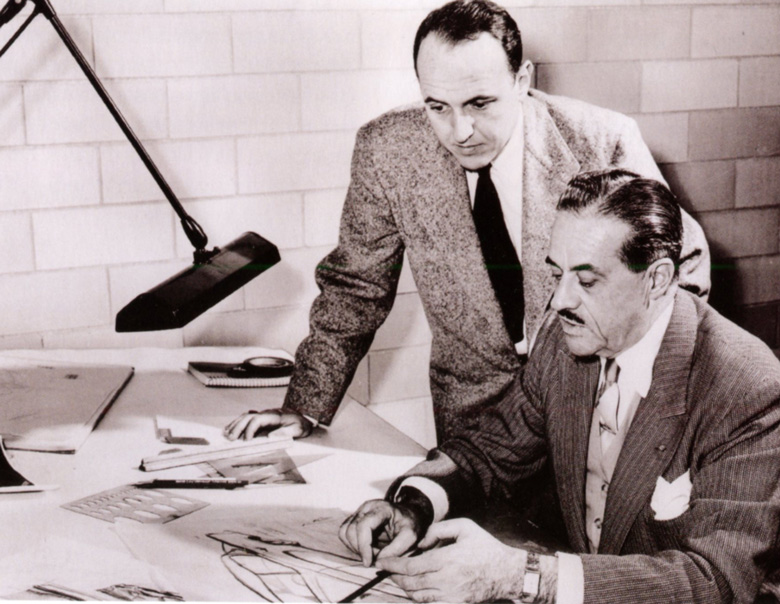
Bob Bourke, left worked with Loewy at Studebaker and was responsible for Stude’s 1953 Starliner coupe.
While under Fetherston’s care, much material was added, mostly much-needed information and photos of and associated with Raymond Loewy, courtesy of David Hagerman. Delving into the designer’s past, Elitch found a comment from the 1940s which sums up the essence of Raymond Loewy: “…Loewy is the only American designer who can cross the country in a car, train or plane of his own design,” which says a lot about the range of Loewy’s talents and influences. Loewy was much admired and much-criticized, but he was on the forefront of industrial design at a time when America was just beginning to mass produce virtually everything. He was an artist, a manager, a creator, an ambitious self-promoter but extremely influential.
From the beginning, Elitch wanted this book to be not only about the Loraymo, but about automotive and industrial design. A long time student of both European and American automobile styling (and the stylists), Elitch wanted to present both Loewy and the Loraymo in a wider context, for only by doing so can one both understand and appreciate both Loewy and his very special Lancia. While this was achieved, the elements are varied and don’t easily fall into a nice logical order. Elitch broke the topics up thusly:
I Preface
II Loewy and the Creative Process
III Loewy’s Mission
IV The Lancia Connection
V The Lancia Loraymo
VI The Disappearance
VII The Avanti
VIII Loewy and the Loraymo Legacy
In the first several chapters, Elitch addresses the difference between art and industrial design, what makes a successful automobile design, Loewy’s contributions to the field of industrial design, and Loewy’s personal history. He adds a section on the impact of GM on Automobile design and the influence of Alfred Sloan and Harley Earl; seemingly off topic but contributes to our understanding of the times in which Loewy lived.
So we take a rather winding but pleasurable road to get to the Loraymo story itself and in the process learn a lot about American design, industrial design and the many aspects of Loewy’s career and personality. It all needs to be there, but the flow could have been improved.
Following the sections on automotive design, Elitch takes a look at the history of Lancia and in particular, the Flaminia. He presents a section about special bodied Flaminias of the same era, including the Nardi specials and Zagatos. These cars were the contemporaries of the Loraymo and serve to illustrate what others created on the same platform.
Then, with help from Steve Snyder and Armand Giglio, Elitch does even more research and puts together a remarkable saga of the Loraymo. In one of the many new anecdotes about the car, Snyder recounts that when the Loraymo was in the possession of one David Rives, sometime in the early 1970s (precise date unknown), Rives met Loewy on the road while driving the Loraymo, which was now red. Loewy stopped, a conversation ensued, and Dave’s friend snapped a photo of Rives and Loewy in front of the Loraymo alongside the road. Yet, Steve Snyder said that Rives told him that Loewy did not seem all that interested in the car or its history since Loewy had long since gotten rid of it. Apparently the Loraymo for Loewy was yesterday and Loewy was very much about tomorrow. However, the photos of the car as taken by Rives, and later as discovered by an Alfa enthusiast Marco Mercado (who really deserves credit for saving the car) and Snyder in early 1987, really help tell the story of the car’s fate.
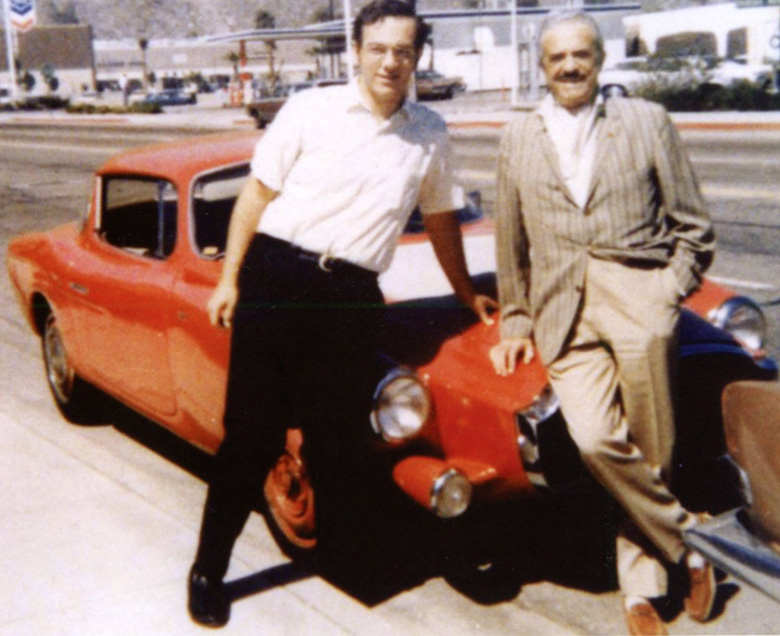
David Rives, left, with his Loraymo and its designer, Raymond Loewy sometime in the early 1970s. This was a chance meeting on the road in Palm Springs.
Part of the story involves the Lancia make itself and the American Lancia Club, which with the efforts of Snyder and Armand Giglio, handed the newly rediscovered Loraymo over to the Lancia Museum in 1987, who in turn restored it to its present condition (it was most recently seen at the Autoclassica in Milan). Elitch then compares the Loraymo to Loewy’s Studebaker Avanti, and the traces become readily apparent.
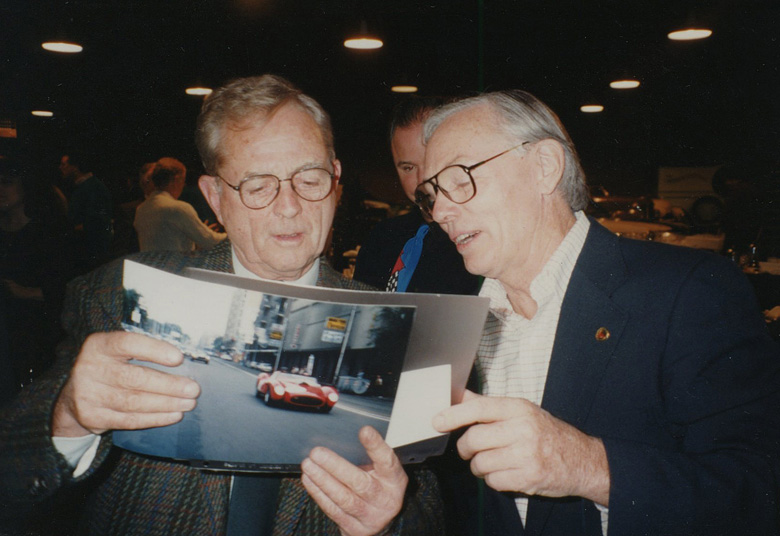
Steve Snyder, who did so much to help save the Loraymo, talks to the late Phil Hill (left). Photographer unknown.
There is an index, which is fairly complete. Although there are no notations or bibliography, quotes and facts are usually documented within the sentence. The Loraymo is an unusual car and the book is as unusual and as surprising as the car it describes. Not a one – marque book nor a history of design, Lancia, Loraymo and the Loewy Logic of Industrial Design is a unique and important portrait of a man, an era, and a car. And like the Loraymo itself, it is very deserving of your attention. In my opinion, Elitch is one of the few guys who has the comprehensive background needed to take on such a project; he is as well versed in both American and European automotive design, in Lancias as he is in Studebakers and has owned and restored cars from both sides of the pond.
There will only be five hundred copies printed; anyone interested in automotive design, Studebaker, Loewy, Lancia or the Loraymo would be well advised to buy now before those copies, like the Loraymo once did, disappear.
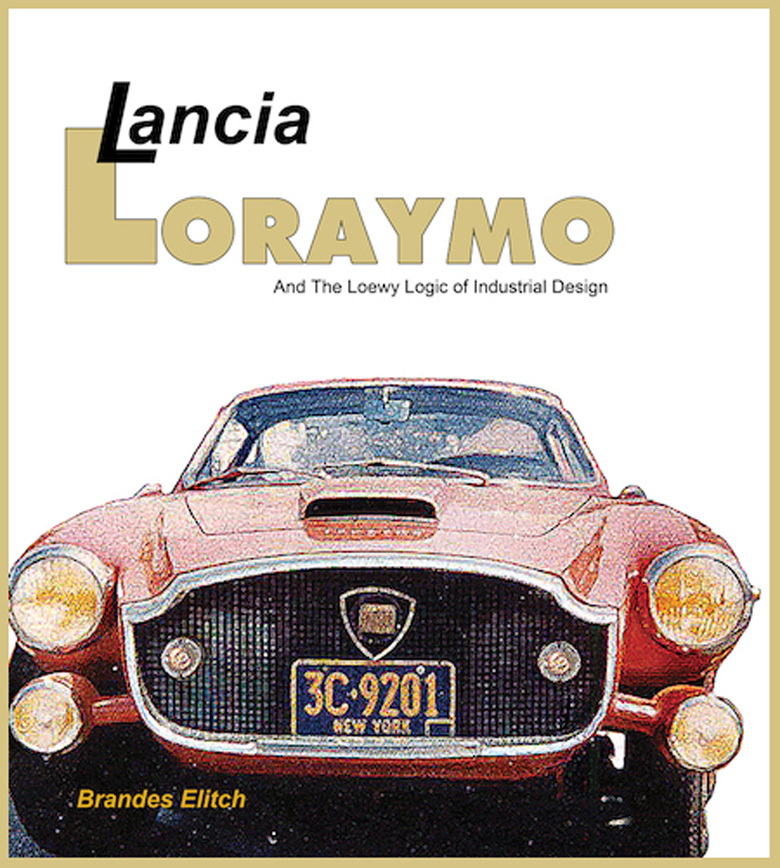
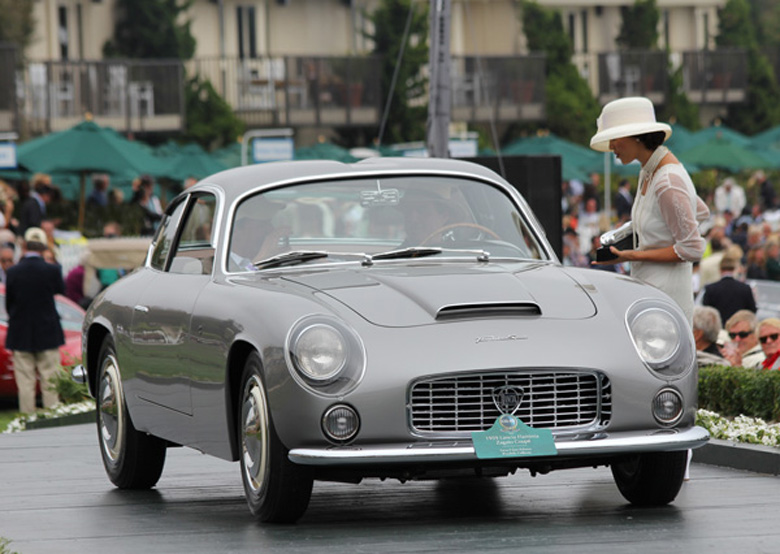
Et Al….This should be very interesting….further I was in France during the 60’s and I believe that Mr Loewy had commissioned an American living in France to fabricate a steering wheel with a “clock” fixed in one of the steering wheel spokes…do not believe the wheel was finished…..Interesting..
Looks great! Thanks Brandy and Steve for your efforts!
The car is a very nice comparison of “American Industrial Design” vs the simplicity and elegance of European cottage coach building of that era.
Will never understand what people see in this guy’s (his, not his staff) designs. This Lancia is almost as gross as his ’59 Cadillac.
Bentley T jnr explains his position well enough by clearly stating “Will never understand……” so I won’t try to convert him, but for the rest of us that do understand, it is good to see this subject get the treatment it deserves. Yes Loewy was apparently a vain, egotistical, champion of self-promotion but he did have the knack to bring the right people to the right job and get the best out of them. His book ‘Industrial Design’ is as good a reference as any on what shaped the 20th century, and his input at Studebaker was influential for years after. The Avanti story alone is great read (although I really can’t see as much of the Loraymo in it although Loewy claims it was a major influence) and under pressure four men, Loewy, Tom Kellogg, BobAndrews and John Epstein shut themselves away in a rented home in Palm Springs to create the Avanti in six weeks. Interestingly the name Loraymo was derived from the cable address of his New York office. Also it is not surprising he was not terribly interested in seeing Mr Rives driving the Loraymo as the rear fender of the car parked in front seems to imply Mr Loewy was driving himself in an Avanti at the time!
when my flaminia zagato was getting checked over in ’63 in the lancia factory garage in torino a man took me a few feet away and partially pulled back the cover on this car and asked if i might be interested. there was more dust on the car than there was on the cover. i took a look at the ugly thing and said no thanks. 3 years later i also turned down tom tjaarda’s offer of a cisitalia coupe for $6k. looked slightly misproportioned and too plain for my oklahoma taste. oh, i could go on…but couldn’t we all?
p.s. that flaminia zagato is sitting waaaay too high in back
Whether or not you are a fan of Loewy, one has to admire his many accomplishments. I for one am interested and looking forward to the read. Elitch and Snyder are both well seasoned auto authorities well respected for their accomplishments. THIS NEW BOOK should be a treasure to all design fans.
Got an interesting surprise, yesterday. Was at an Alfa dealership in Greer, SC, about 80 miles from my home in Black Mountain, NC, checking out a 4C, which I’m now saving my pennies to buy (yes, I know: we’re talking about a lot of pennies here!)
After the salesman and I had gone over the details of the Alfa, and what it would take to purchase it, I told him the reason I was so interested in that particular car was because I had owned a car, in the late-60’s and early-70’s that was as radical, design-wise, as the Alfa 4C is today, and that I missed not having that “exclusivity,” even if it meant getting pulled over, every other day back then, by car-loving cops who were driven nuts by not being able to identify what they were seeing, so would pull me over and say, “Uh, you were following too close (this, on the Hollywood Freeway, during morning rush hour[!]). By the way, what kind of car is this?” Or, “One of your brake lights is out. By the way, what kind of car is this?” Or, “You forgot to signal when you changed lanes back there (this at 3 o’clock in the morning, when I [and the cop] were the only two cars on the road[!]) By the way, what kind of car is this?” And so on.
I then told the salesman he could probably pull my former car up on his computer, and learn a little bit about it. Which he did.
So, what was the surprise?
Simply this: watching him scroll down through a story on the car and suddenly SEEING A MUCH YOUNGER VERSION OF MYSELF LOOKING BACK AT ME FROM THE COMPUTER SCREEN, standing next to the car’s designer, whom I’d met by chance in Palm Springs.
So, if anybody’s interested in the millions of stories around the car, between 1968, when I purchased it, and 1979, when it was stolen off the street behind my house — and to see a lot more pictures of it– feel free to get in touch with me.
Thanks,
David